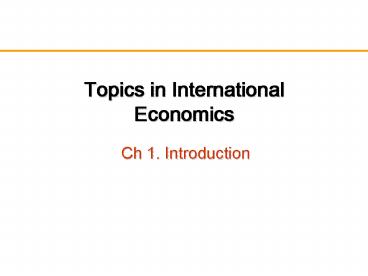Topics in International Economics - PowerPoint PPT Presentation
1 / 8
Title:
Topics in International Economics
Description:
... deficits in the 1980s and '90s, the US became the largest debtor in the world. ... The currency has been on managed float ever since. ... – PowerPoint PPT presentation
Number of Views:2165
Avg rating:3.0/5.0
Title: Topics in International Economics
1
Topics in International Economics
- Ch 1. Introduction
2
T1 The U.S. as the largest debtor
- The US current account deficit increased to 144
billion in 2004Q1 from 127billion in 2003Q4.
(US GDP in 2003 11,000 billion) - Why does it arise?
- Why does it matter?
3
- Net international investment position declines
each period by the amount of current account
deficit. - As a result of large current account deficits in
the 1980s and 90s, the US became the largest
debtor in the world. - NIIP of the US -2430 billion (2003)
-2233 billion (2002) - It is important to compare these numbers to the
size of the economy.
4
T2The euro
- The euro, introduced in 1999, became the currency
of 12 EU members. - Germany, France, Italy, Belgium, Netherlands,
Luxemburg, Ireland, Spain, Portugal, Austria,
Finland, Greece - What are the benefits and costs of the monetary
union (giving up own national currencies and
adopting a common currency)? - Why did the UK, Sweden, and Denmark opt out?
5
Dollarization
- In a different context, El Salvador has adopted
the US dollar as legal tender. - A new meaning of dollarization
- Why would any country want to give up its own
currency and adopt some other countrys currency?
6
T3 Exchange rate movements
- Exchange rate movements have been large.
- Can we explain them?
- Are flexible exchange rates more desirable than
fixed rates? - http//www.x-rates.com/
7
T4 Financial Crises
- Currency crises became more frequent.
- ERM (exchange rate mechanism), 1992
- Mexico, 1994
- East Asia, 1997
- Big devaluations and subsequent economic
collapses - How to explain currency crises? How to prevent
them?
8
T5 Choice of exchange rate regime
- Chinese Renminbi had been pegged to the US dollar
since 1994 until recently. - Large trade surpluses of China became a political
issue. - The US government and many economists recommend
increased exchange rate flexibility. - China revalued the RMB from 8.28 to 8.11 yuan per
USD on July 22, 2005. The currency has been on
managed float ever since. - What kind of exchange rate system would be most
appropriate for China?































